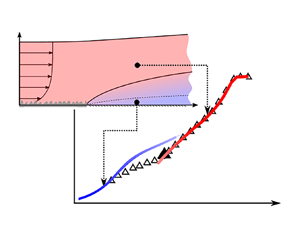Article contents
Experimental study of a turbulent boundary layer with a rough-to-smooth change in surface conditions at high Reynolds numbers
Published online by Cambridge University Press: 27 July 2021
Abstract

This study presents an experimental dataset documenting the evolution of a turbulent boundary layer downstream of a rough-to-smooth surface transition. To investigate the effect of upstream flow conditions, two groups of experiments are conducted. For the Group-Re cases, a nominally constant viscous-scaled equivalent sand grain roughness  $k_{s0}^{+}\approx 160$ is maintained on the rough surface, while the friction Reynolds number
$k_{s0}^{+}\approx 160$ is maintained on the rough surface, while the friction Reynolds number  $Re_{\tau 0}$ ranges from 7100 to 21 000. For the Group-ks cases,
$Re_{\tau 0}$ ranges from 7100 to 21 000. For the Group-ks cases,  $Re_{\tau 0}\approx 14\,000$ is maintained while
$Re_{\tau 0}\approx 14\,000$ is maintained while  $k_{s0}^{+}$ ranges from 111 to 228. The wall-shear stress on the downstream smooth surface is measured directly using oil-film interferometry to redress previously reported uncertainties in the skin-friction coefficient recovery trends. In the early development following the roughness transition, the flow in the internal layer is not in equilibrium with the wall-shear stress. This conflicts with the common practise of modelling the mean velocity profile as two log laws below and above the internal layer height, as first proposed by Elliott (Trans. Am. Geophys. Union, vol. 39, 1958, pp. 1048–1054). As a solution to this, the current data are used to model the recovering mean velocity semi-empirically by blending the corresponding rough-wall and smooth-wall profiles. The over-energised large-scale motions leave a strong footprint in the near-wall region of the energy spectrum, the frequency and magnitude of which exhibit dependence on
$k_{s0}^{+}$ ranges from 111 to 228. The wall-shear stress on the downstream smooth surface is measured directly using oil-film interferometry to redress previously reported uncertainties in the skin-friction coefficient recovery trends. In the early development following the roughness transition, the flow in the internal layer is not in equilibrium with the wall-shear stress. This conflicts with the common practise of modelling the mean velocity profile as two log laws below and above the internal layer height, as first proposed by Elliott (Trans. Am. Geophys. Union, vol. 39, 1958, pp. 1048–1054). As a solution to this, the current data are used to model the recovering mean velocity semi-empirically by blending the corresponding rough-wall and smooth-wall profiles. The over-energised large-scale motions leave a strong footprint in the near-wall region of the energy spectrum, the frequency and magnitude of which exhibit dependence on  $Re_{\tau 0}$ and
$Re_{\tau 0}$ and  $k_{s0}^{+}$, respectively. The energy distribution in near-wall small scales is mostly unaffected by the presence of the outer flow with rough-wall characteristics, which can be used as a surrogate measure to extract the local friction velocity.
$k_{s0}^{+}$, respectively. The energy distribution in near-wall small scales is mostly unaffected by the presence of the outer flow with rough-wall characteristics, which can be used as a surrogate measure to extract the local friction velocity.
JFM classification
- Type
- JFM Papers
- Information
- Copyright
- © The Author(s), 2021. Published by Cambridge University Press
References
REFERENCES
- 13
- Cited by





